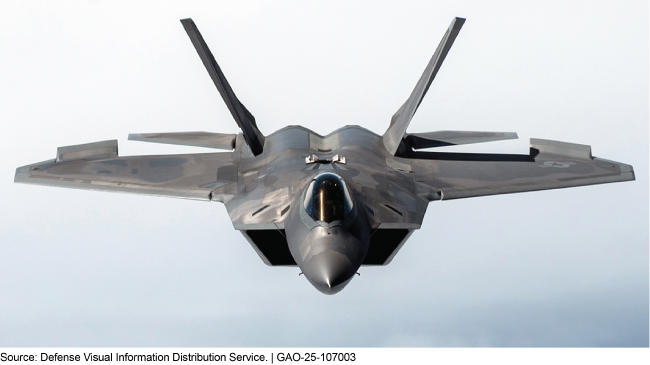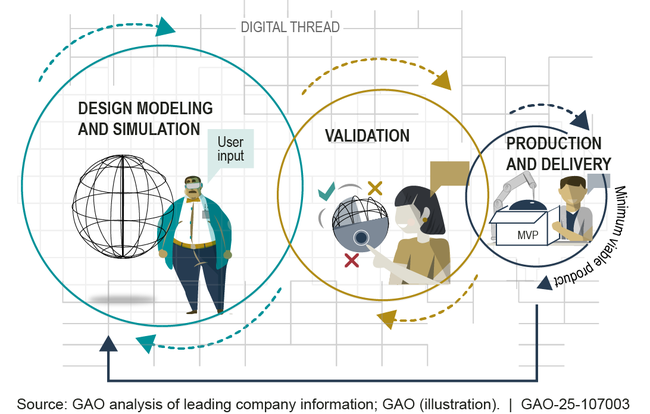DOD Acquisition Reform: Military Departments Should Take Steps to Facilitate Speed and Innovation
Fast Facts
DOD revamped its acquisition policies in 2020 to try to deliver innovative weapons faster.
These weapons are often "cyber-physical" products that combine hardware and software. We previously found that leading companies use iterative design, testing, and feedback processes to get these kinds of products to market quickly.
But some program managers weren't sure how to apply iterative development in their programs. So we recommended the military departments each iteratively develop a cyber-physical product as an example of how it can work. We also recommended they revise acquisition policies to better reflect iterative practices.
DOD is using new methods in an effort to deliver modernized F-22s faster

Highlights
What GAO Found
The Department of Defense (DOD) revamped its acquisition policies in 2020, with the intent to deliver innovative technologies to the user more quickly. These reforms, known collectively as the “adaptive acquisition framework,” established four pathways that weapon system acquisition programs can follow: urgent capability, middle tier, major capability, and software.
Each military department issued policies in alignment with DOD's goals and framework, but these policies do not consistently reflect leading practices. In July 2023, GAO found that leading companies use an iterative development structure that includes continuous cycles of design modeling, validation, and production. These iterative processes enable the companies to get products that combine hardware and software—known as cyber-physical products—to market quickly. The continuous cycles allow the companies to gain specific knowledge, such as assurance that the design meets the most essential user needs.
Iterative Cycles of Design, Validation, and Production to Develop a Minimum Viable Product

While military departments' policies for the software acquisition pathway fully incorporated an iterative development structure, GAO did not find a full structure of iterative development for the urgent capability, middle tier, and major capability acquisition pathways. For example, while Air Force and Navy urgent capability acquisition policies discussed how to refine requirements, they did not include other elements of iterative development such as information on applying user feedback to ensure the design meets essential user needs. Without revised policies and guidance on and examples of how programs can use an iterative development approach, programs across pathways are missing opportunities to deliver capabilities with speed and innovation.
The programs GAO reviewed had different understandings of iterative development. Moreover, some program officials stated that they did not think it applied to or was feasible for their program. A pilot program, resulting in practical examples of cyber-physical products that have used an iterative development structure, could provide future programs with lessons learned and opportunities to acquire weapon systems faster.
Why GAO Did This Study
DOD struggles to promptly deliver capabilities to its warfighters. The 2022 National Defense Strategy emphasized increasing the speed of delivery to meet emerging threats. GAO found in July 2023 (GAO-23-106222) that leading companies iteratively develop cyber-physical products with speed.
House and Senate reports include provisions for GAO to assess the military departments' approaches to implementing DOD's adaptive acquisition framework and incorporating leading practices for product development. This report describes the departments' implementation of the framework and assesses the extent to which their approaches are designed to facilitate speed and innovation in acquisition. To do this work, GAO interviewed officials and reviewed relevant policies and guidance from DOD and the three military departments. GAO selected nine acquisition programs, including at least one from each department, and interviewed program officials and reviewed documentation.
Recommendations
GAO is making a total of six recommendations to the departments of the Army, Navy, and Air Force to each revise acquisition policies and guidance for weapon systems and designate one or more new cyber-physical capabilities as pilot programs that provide lessons learned on using leading practices for each pathway. DOD concurred with four recommendations, and partially concurred with two to the Army, stating that the Army did not consider them fully applicable to a specific pathway. GAO maintains their applicability.
Recommendations for Executive Action
| Agency Affected | Recommendation | Status |
|---|---|---|
| Department of the Air Force | The Secretary of the Air Force should revise its acquisition policies and relevant guidance to reflect leading practices that facilitate speed and innovation, using continuous iterative cycles that ensure the design meets user needs, the development of a minimum viable product, and the optimization of processes to produce further iterations. (Recommendation 1) |
DOD and the Air Force concurred with our recommendation. In March 2025, the Air Force identified four policies that it plans to revise and publish in 2026. We will continue to track the Air Force's progress.
|
| Department of the Army | The Secretary of the Army should revise its acquisition policies and relevant guidance to reflect leading practices that facilitate speed and innovation, using continuous iterative cycles that ensure the design meets user needs, the development of a minimum viable product, and the optimization of processes to produce further iterations. (Recommendation 2) |
DOD and the Army partially concurred with this recommendation. As of September 2025, Army officials stated that they are waiting for relevant policy updates from DOD to revise supplemental guidance.
|
| Department of the Navy | The Secretary of the Navy should revise its acquisition policies and relevant guidance to reflect leading practices that facilitate speed and innovation, using continuous iterative cycles that ensure the design meets user needs, the development of a minimum viable product, and the optimization of processes to produce further iterations. (Recommendation 3) |
DOD and the Navy concurred with this recommendation. As of September 2025, the Navy has not documented any actions taken to implement this recommendation.
|
| Department of the Air Force | The Secretary of the Air Force should designate one or more new cyber-physical capabilities as pilot programs that provide lessons learned on using leading practices to facilitate speed and innovation for programs on each acquisition pathway directly related to weapon systems. (Recommendation 4) |
DOD and the Air Force concurred with this recommendation. In the Spring of 2025, the Air Force developed criteria for evaluating candidate programs, however it decided to omit the Urgent Capability Acquisition pathway because it felt the leading practices are best leveraged after an Urgent Capability Acquisition is completed with transition to another pathway. GAO maintains the applicability of the leading practices to each pathway. By June 2025, the Air Force gathered lessons learned from the Cloud-Based Command and Control, Angry Kitten Combat System, and F-15EX programs that it plans to disseminate on various websites through January 2026. While the lessons learned for Cloud-Based Command and Control and Angry Kitten Combat System reflect the use of some aspects of GAO's leading practices, such as a minimum viable product, the lessons learned for F-15EX reflect general lessons learned for the program, rather than specifically the use of leading practices to facilitate speed and innovation.
|
| Department of the Army | The Secretary of the Army should designate one or more new cyber-physical capabilities as pilot programs that provide lessons learned on using leading practices to facilitate speed and innovation for programs on each acquisition pathway directly related to weapon systems. (Recommendation 5) |
DOD and the Army partially concurred with this recommendation. As of September 2025, Army officials stated that they are in the process of gathering information on pilot programs and associated lessons learned.
|
| Department of the Navy | The Secretary of the Navy should designate one or more new cyber-physical capabilities as pilot programs that provide lessons learned on using leading practices to facilitate speed and innovation for programs on each acquisition pathway directly related to weapon systems. (Recommendation 6) |
DOD and the Navy concurred with this recommendation. As of September 2025, the Navy has not documented any actions taken to implement this recommendation.
|
